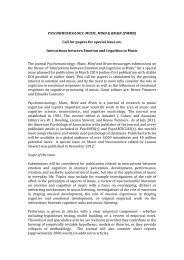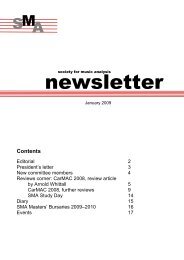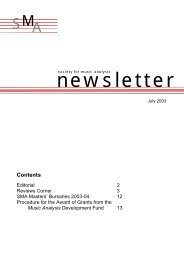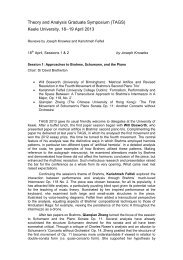Here - Society for Music Analysis
Here - Society for Music Analysis
Here - Society for Music Analysis
Create successful ePaper yourself
Turn your PDF publications into a flip-book with our unique Google optimized e-Paper software.
Large-scale structure in Sergei Prokofiev’s PianoSonata No. 8 in B-flat.While the larger part of musicological study on Sergei Prokofiev remains within the field ofbiography, the analytical study of his music has seen a growing interest in recent decades. Threescholars in particular have published analyses challenging some simplistic, tonally-biased ideasexpressed about Prokofiev’s music in earlier literature. Neil Minturn focuses on the structuralproperties of certain pitch-class sets; Richard Bass explores the interpretation of chromaticphenomena within an expanded framework of tonal functions; while Deborah Rifkin seeks toaddress the purpose behind unusual chromaticisms with her theory of structural motifs. Theirfindings shed light unto hitherto unexplained phenomena in Prokofiev’s music, while supporting theexisting observation that his musical style consists of an eclectic mixture of classical and modernelements.One area of study which has received relatively little attention is the large-scale construction inProkofiev’s works. While some scholars have noted that Prokofiev has a tendency to employ clearlydefined classical <strong>for</strong>ms, the exploration of the harmonic <strong>for</strong>ces conventionally governing these <strong>for</strong>mshas been taken <strong>for</strong> granted. I believe this is a significant over-sight, as the composer’s harmonicexploits traverse a much richer array of keys and dissonances than is usually contained within the<strong>for</strong>ms which he employs. My paper will suggest a way of reconciling Prokofiev’s use of classical<strong>for</strong>ms with his chromaticised harmonic language by positing a neo-Riemannian background <strong>for</strong> hisPiano Sonata No. 8. I will attempt to show how such a reading might be useful <strong>for</strong> discussing themusic’s expressive and functional gestures.Olga SologubThe University of Manchesterolga.sologub@postgrad.manchester.ac.ukA/V Requirements: Projector with cable <strong>for</strong> PC and audio output Piano/keyboard







